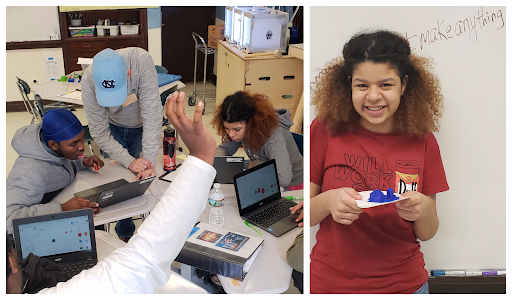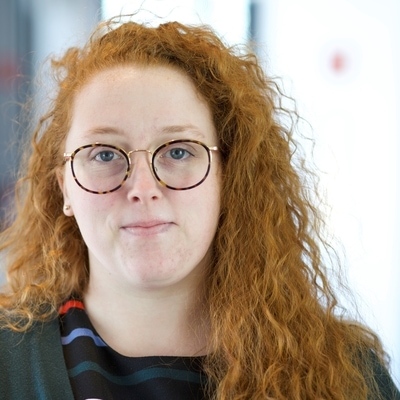Making for Social Justice at Brighton High School
Topics

Together, educators are doing the reimagining and reinvention work necessary to make true educational equity possible. Student-centered learning advances equity when it values social and emotional growth alongside academic achievement, takes a cultural lens on strengths and competencies, and equips students with the power and skills to address injustice in their schools and communities.
A Boston Turnaround School wins the Autodesk-sponsored "Make It Real" competition, bringing a social justice-oriented maker education to the students at Brighton High.
Today's challenges will be solved by tomorrow's designers. Students and educators require support now for navigating future shifts. They need inspiration and resources to adapt to the myriad of new ways we will learn and work, and for reimagining how we will solve our most pressing problems. Compounding that is that many of our communities lack access to the opportunities shaping our future.
Steven Gianquitti, the director of partnerships and work-based learning at Brighton High School in Boston, says, "Many people outside of schools don't realize what an isolating profession teaching can be."
Collaborating with industries in the local innovation ecosystem, educators in the Boston school district have been transforming their instructional practices to provide their students with learning experiences steeped in real-world contexts that engage the senses, emotions, and mind.

Teachers from three different Boston Public Schools, including Brighton High, role play the types of hands-on engineering and team-building activities they might do with students, while completing a teacher externship at Autodesk. (Courtesy of Autodesk)
Since summer 2017, Autodesk has hosted over 40 district educators, principals, and district-level leaders at its Autodesk Technology Center in Boston's Seaport District, the heart of the city's innovation hub. The purpose is to create an inviting collaborative space for educators to experiment, learn, and apply cutting-edge tools and design thinking methodologies to improve learning in the classroom and prepare students for future work.

In the summer of 2018, teachers from two of Boston's Turnaround Schools spent two weeks at the Autodesk Technology Center in Boston in order to immerse themselves in the culture of innovation. (Courtesy of Autodesk)
Each year, Autodesk sponsors the "Make It Real" competition to give schools all over the U.S. and Canada a chance to win maker space equipment. The goal of the contest, now entering its third year and $100,000 of equipment awarded to date, is to offer curious and action-oriented educators and students additional resources to experiment with new ideas.
The contest was initially conceived as a way to encourage a conversation around the value of maker education, but it has grown to also become an inspiration point for innovative educators to network, exchange ideas, foster safety in taking risks, and continue to grow. That's especially true for this year's contest winners, a group of teachers and students at Brighton High School. The team's contest application video describes the school's creative spirit of "making with what we have."

Students from Boston International Newcomers Academy, winners of the first Make It Real contest in 2018, were featured in a promotional film for the contest alongside James White of the New England Patriots. (Courtesy of Autodesk)
More Than a Turnaround
For the winning team at Brighton High School, it was not their first time working with Autodesk. In the summer of 2018, a team of Brighton High School teachers, including Tim Harrison, Anthony Browne, and Marlon Forrester, participated in a summer residency at Autodesk as teacher externs. They spent 10 days shadowing experts in the practical application of software like Tinkercad in a 21st-century workplace, while applying this new insight to rethink the curriculum they teach.

During his externship at Autodesk, Tim participated in a design challenge in which he used CAD software to express a concept he imagined that would improve his students' learning environment. (Courtesy of Autodesk)
As teachers in a Turnaround School, they expressed that they often feel stigmatized that their school's "low-performing" status overshadows the incredible work their students and fellow educators do each day.
When asked what motivated him to apply to be an extern, Tim explained that he was driven by the "opportunity to be part of a team of like-minded educators playing with a fully conceptualized idea."
With little initial experience using CAD software, Tim was soon able to use 3D design skills to express his ideas for improving his students' learning environment and design rich units of study for his special education students. These units integrate the use of CAD with the exploration of important questions like: What can and should be done to help make Boston more welcoming to students across different races and cultures?

Tim documented one of the Tinkercad projects he created for his students—in which students explored demographics data from Boston's neighborhoods through making 3D population maps—by publishing his lesson plan on Instructables. (Courtesy of Tim Harrison)
All three teachers demonstrated increasing pride in showcasing their contributions to the evolution of Brighton High's MADE (Media, Arts, Design and Entrepreneurship) for Social Justice curricular pathway. Tim even started using the hashtag #MoreThanTurnaround in celebratory social posts.

During the externship, the teachers had the opportunity to conduct empathy interviews with students to investigate ways they might make their learning environments more user-centered. (Courtesy of Autodesk)
From Externships to Maker Spaces
After returning to school in the fall, the Brighton team couldn't wait to apply their new skills in their classrooms and share their new knowledge with students and colleagues.
After his experience as an Autodesk teacher extern, Tim felt confident to start experimenting back at Brighton High. He knew that the school already had a 3D printer that didn't see enough use due to a lack of capacity. With his beginner's background in CAD, Tim started to tinker with it. He was inspired by what he was creating and found that his students were also excited by it. So much so that Tim soon realized the students could make great use of an entire maker space.
When the Tinkercad "Make It Real" competition came along, the team at Brighton High jumped at the chance to work with Autodesk again and give their students unprecedented access to 21st-century learning and materials.

Brighton High students learned 3D design and 3D printing, as well as other core skills, through a "tiny house" project. (Courtesy of Tim Harrison)
Moving Forward
The students of Brighton High's STEM Club helped compose the proposal for the Make It Real competition. They also helped design the maker space, making them the best candidates to run it. And next school year, the team is planning on making the maker space entirely student-run. In the future, they're hoping they can inspire other groups at Brighton High to use the space, too.
Steven sees the teachers' collaboration with Autodesk and the new resources they gained through the Make It Real challenge as instrumental to the development of the school's MADE for Social Justice curricular pathway. Furthermore, he says, the connections formed at Autodesk are continuing to deepen and manifest in interesting ways.
He reflected, saying, "By putting themselves out there, and seeing themselves thrive in an amazing innovation space like Autodesk, they can now see themselves more easily in other similar spaces. And not only that, but they can see their students in those spaces, too. That's empowering."





